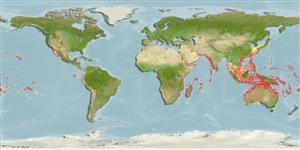Common names from other countries
Environment: milieu / climate zone / depth range / distribution range
Ecologie
Rifbewoner; brakwater; diepteverspreiding 0 - 95 m (Ref. 96667). Tropical
Indo-Pacific: Red Sea to Cocos Islands.
Length at first maturity / Size / Gewicht / Leeftijd
Maturity: Lm ? range ? - ? cm Max length : 2.0 cm CL mannelijk/geslacht niet bekend; (Ref. 107481); 2.325 cm CL (female)
It is found on pneumatophores and roots of Avicennia marina (Ref. 107904). Active during low tide, but many are observed at high tide moving to mangrove roots above water level. Also lives among roots of Rhizophora mucronata. Feeds on mainly on macroalgae, a bit of mangrove leaves and mud; animal items were rare but may be an opportunistic feeder to a certain degree (Ref. 108401).
Life cycle and mating behavior
Geslachtsrijpheid | Voortplanting | Kuitschieten | Eieren | Fecundity | Larven
Members of the order Decapoda are mostly gonochoric. Mating behavior: Precopulatory courtship ritual is common (through olfactory and tactile cues); usually indirect sperm transfer.
MarineSpecies.org. 2050. (Ref. 3477)
Status op de Rode Lijst van het IUCN (Ref. 130435)
Status bij CITES (Ref. 108899)
Not Evaluated
Not Evaluated
Gebruik door de mens
| FishSource |
Tools
Meer informatie
Leeftijd/Grootte
Groei
Lengte-gewicht parameters
Lengte-lengte parameters
Morfologie
Larven
Abundantie
Internet-bronnen
Estimates based on models
Preferred temperature
(Ref.
115969): 24.3 - 29, mean 27.7 (based on 1472 cells).
Prijsklasse
Unknown.
